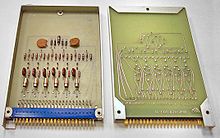Computer module
This articleneeds additional citations forverification.(September 2022) |

Acomputer moduleis a selection of independent electronic circuits packaged onto acircuit boardto provide a basic function within acomputer.[1]An example might be aninverterorflip-flop,which would require two or moretransistorsand a small number of additional supporting devices. Modules would be inserted into a chassis and then wired together to produce a larger logic unit, like an adder.
History
[edit]Modules were the basic building block of most early computer designs, until they started being replaced byintegrated circuitsin the 1960s, which were essentially an entire module packaged onto a singlecomputer chip.Modules with discrete components continued to be used in specialist roles into the 1970s, notably high-speedmodular designslike theCDC 8600,but advances in chip design led to the disappearance of the discrete-component module in the 1970s.
See also
[edit]References
[edit]- ^Fuller, S.; Siewiorek, D.; Swan, R. (1975)."Computer modules - an architecture for a modular multi-microprocessor".Proceedings of the 1975 annual conference on - ACM 75.Not Known: ACM Press. pp. 129–133.doi:10.1145/800181.810301.ISBN9781450374811.S2CID17439181.
